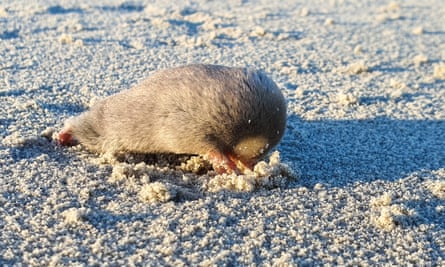A rare, shimmering golden mole that hasn’t been seen since before World War II has been found again “swimming” in the sand near Port Nolloth, a coastal town in northwestern South Africa.
The De Winton’s golden mole, known as Cryptochloris wintoni, was once thought to be extinct. This species resides in subterranean tunnels and has not been observed since 1937. Its name is derived from its oily secretions that help it move through sand dunes, giving its fur a “golden” appearance. Unlike other moles, it does not construct traditional tunnels, making it difficult to find.
This creature is visually impaired and relies on its acute sense of hearing. When it detects any vibrations from movement above ground, it quickly runs away. The global conservation group Re:wild has listed this species as one of the “most wanted” lost species.
After 86 years since its previous sighting, the mole has been recently found again due to a thorough search conducted by conservationists and a specially trained border collie named Jessie. The results of their discovery have been documented in the Biodiversity and Conservation journal.
Esther Matthew, a senior field officer at the Endangered Wildlife Trust (EWT), expressed her excitement about being part of a team searching for lost species. She described finding one as the icing on the cake.

Scientists from EWT and the University of Pretoria collaborated with a canine named Jessie, who signaled the discovery of a scent by lying down on the spot. In recognition of her contribution, Jessie received the opportunity to play with her tennis ball as a reward.
On every break, they gathered a soil specimen that was afterwards analyzed for environmental DNA (eDNA). This method identifies DNA from skin cells, urine, feces, and mucus that the moles leave behind as they traverse the dunes. By utilizing this approach, the group searched through a maximum of 18km (11.2 miles) of dunes in one day. In total, they collected 100 sand samples and eventually came across two De Winton golden moles.

In 2021, the team conducted field research and suspected they had discovered the mole. However, De Winton’s appearance closely resembles that of other golden moles, so the finding could not be confirmed until genetic sequencing of samples was performed.
Cobus Theron, a senior conservation manager at EWT and part of the search team, expressed confidence that the De Winton’s golden mole was not extinct, despite doubts from others. The team not only found the mole, but also discovered the potential of eDNA technology for helping other endangered species.
There are 21 identified types of golden moles, with the majority residing exclusively in South Africa. The researchers uncovered proof of three additional species, including the endangered Van Zyl’s golden mole.
In 2021, the study revealed that EWT has discovered four additional groups of De Winton’s golden moles. Researchers speculate that Port Nolloth is a suitable habitat for a thriving population of these moles. Unfortunately, the region is at risk due to diamond mining and lacks protection.
“We must pinpoint key areas for our conservation initiatives and establish protected regions to ensure the preservation of these species,” stated JP Le Roux, a previous field officer for EWT.
Find more age of extinction coverage here, and follow biodiversity reporters Phoebe Weston and Patrick Greenfield on X (formerly known as Twitter) for all the latest news and features
Source: theguardian.com


